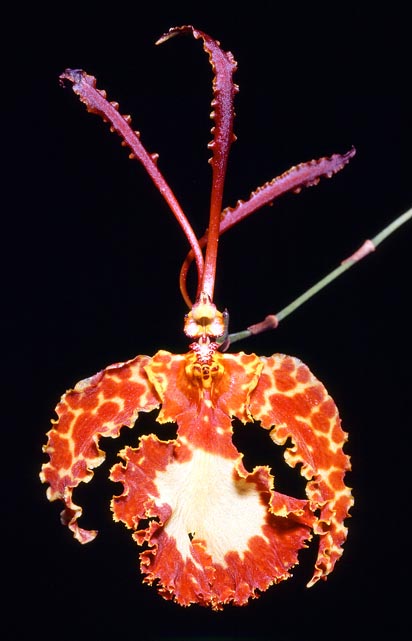Family : Orchidaceae

Text © Pietro Puccio

English translation by Mario Beltramini

Psychopsis krameriana seems a flying butterfly © Giuseppe Mazza
The name of the genus is the combination of the Greek terms “psyche” = butterfly and “ópsis” = resemblance, with obvious reference; the species is honoured to the German head gardener Kramer who cared the first plant introduced in Europe.
Common names: Kramer’s butterfly orchid (English); orquidea mariposa (Spanish).
The Psychopsis krameriana (Rchb.f.) H.G.Jones (1975) is an epiphytic species with globular pseudobulbs, slightly compresses laterally, of about 2 cm of diameter, with at the apex one only oblong leaf, coriaceous, rigid, of intense green colour speckled of purple, especially externally, 10-30 cm long and 3-6 cm broad.
Erect inflorescence, from the base of the pseudobulb, on a peduncle up to more than 70 cm long, with prominent nodes, carrying flowers opening in succession, with at most two flowers open at the same time, lasting about one week; once the blooming has finished a new inflorescenze may be produced by the upper nodes, therefore the plant can remain flowering for long periods of time.
The flowers are 10-12 cm vertically long and 8 cm broad with brick red dorsal sepal and petals, with yellow margins, yellow with lateral sepals speckled of brick red, yellow labellum with brick red spots at the edges. Erect dorsal sepal, linear-spatulate with pointed apex and undulated and curved margins, 5,5-8 cm long and about 0,5 cm broad, with lateral sepals ovate, curved, 3,5-5 cm long and 1,5-2,5 cm broad, with undulated margins, petals of similar shape to the dorsal sepal, 6-7 cm long and 0,4-0,8 cm broad, with undulated and curved margins, trilobed labellum, about 4 cm long and 2,5-4 cm broad, with bilobed median lobe and undulated margins, erect column with reniform wings and two protuberances surmounted by blackish glands, similar to small antennae, above.
It reproduces by seed, in vitro, and by division, with each section provided with at least 3-4 pseudobulbs.
The Psychopsis krameriana is one of the most striking examples of vegetal mimicry, evolutive process which, in this case, grants the flower the most favourable look for the reproduction; the resemblance with a butterfly is accentuated by the long peduncle which allows the flower swaying by the least breeze.
It is a species suitable to warm humid climate with almost constant temperatures, between the 18 and the 28 °C, during the whole year, and high humidity, around the 80%. Waterings and nebulisations, utilizing rain water, or water gotten by reverse osmosis or demineralised, must be frequent and regular, only a slight reduction in winter, but the roots must be able to dry up quickly, thanks to good ventilation.
The fertilizations are to be done during the vegetative period, with hydro-soluble balanced products, with microelements, at ¼ of the dosage suggested on the package, distributed and alternated in way to avoid salts accumulations at the roots.
If it is possible to maintain a high ambient humidity, it can be mounted on bark, raft of cork or of arborescent ferns roots, otherwise is to be cultivated in pots or baskets with much draining and aerated compost, as it does not stand stagnations at the roots, which may be formed by medium sliced bark fragments, sphagnum or coir, or charcoal; movings, repottings and divisions are to be done when the plant gives signs of vegetative re-growth.
The species is inscribed into the appendix II of the CITES (species whose trade is internationally ruled).
Snonyms: Oncidium kramerianum Rchb.f. (1855); Oncidium nodosum E.Morren (1874); Papiliopsis krameriana (Rchb. f.) Morren ex Cogn. & Marsch. (1874); Papiliopsis nodosus E.Morren ex Cogn. & Marchal (1874); Oncidium papilioniforme Regel (1879).
→ For general notions about ORCHIDACEAE please click here.
